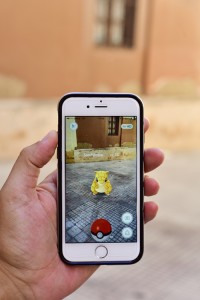Pokémon Goes!
Thursday, July 21st, 2016July 21, 2016
Millions of players are taking to the streets to play Pokémon Go, a mobile gaming sensation released by the software developer Niantic on July 6, 2016. The game builds on the Pokémon game franchise, which first peaked in popularity in the late 1990’s. In Pokémon games, players take on the role of trainers, who capture, collect, and train fantastic monsters called Pokémon. The monsters then fight each other in duels. Each Pokémon has unique abilities and a clever name, such as Pikachu (whose “static” ability can paralyze), Charmander (whose “blaze” ability can burn), and Squirtle (whose “torrent” ability makes him a fast swimmer). When the creatures are not fighting, they are kept in pocket-sized balls. The term Pokémon is short for pocket monsters.

Pokémon Go leads a player on the game path in Tarragona, Spain, on July 18, 2016.
Credit: © Nito, Shutterstock
Pokémon Go ushers the franchise into the world of augmented reality games. Augmented reality games are electronic games in which computer-generated elements are superimposed over the real world. Pokémon Go players use their mobile phones to search for and capture Pokémon hidden in their surroundings. As the player walks around in the real world, the player’s game avatar moves along a map using GPS. When a Pokémon is close enough to capture, it pops up on the player’s phone screen. Many real world locations such as parks, churches, and coffee shops figure into the game, holding in-game equipment or serving as “gyms,” where players from Pokémon Go’s different teams can compete for control of a particular landmark.
Exploring the real world is an important element of Pokémon Go, and the game’s release stimulated a surge in pedestrian traffic, particularly in locations stocked with virtual equipment or marked as gyms. Fans of the game were pleased to note that it encouraged exploration, exercise, and social interaction among gamers. Many people, however, expressed safety concerns, with reports of pedestrians and drivers being distracted by the game and of gamers trespassing or entering dangerous areas to find Pokémon items.


